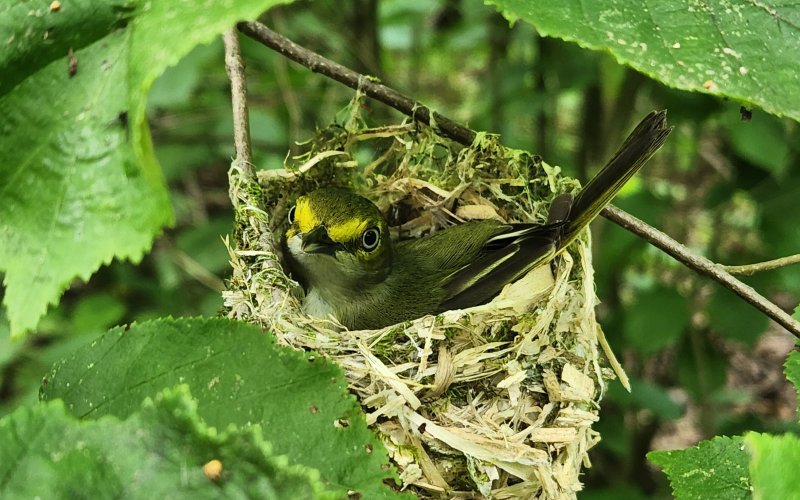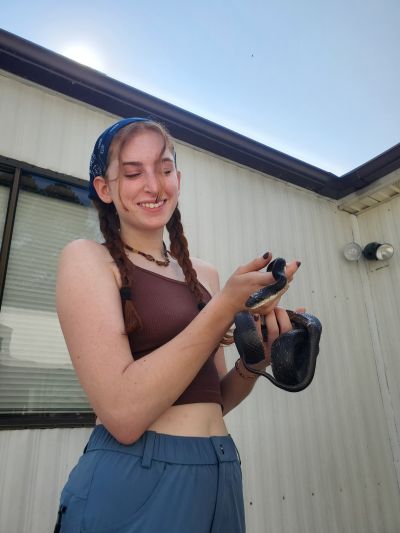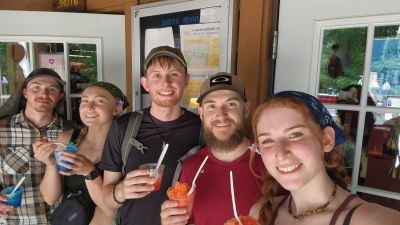UAlbany Summer: Bio Major Researches Birds in the Ozarks

ALBANY, N.Y. (Sept. 5, 2023) — Sarah Palmieri is a senior at the University at Albany, majoring in Biology with a minor in Sustainability. This summer, she traveled to Missouri’s Current River Conservation Area to conduct ornithological research as part of the Missouri Ozark Forest Ecosystem Project.
Over the course of the six-week program, Palmieri undertook hands-on field research, observing and recording birds to measure species richness and diversity in the region. She took some time to share her reflections on working in the Ozarks, including the ways that the experience reinforced her plans to pursue a career in ornithology.
How did you get involved in the Missouri Ozark Forest Ecosystem Project?
I found Missouri Ozark Forest Ecosystem Project (MOFEP) through the Ornithology Exchange, which is a great website for finding jobs in the field of ornithology. There are thousands of opportunities posted on this website including short-term, long-term, academic and volunteer positions.

Where were you based for your field work?
The field tech crew that I was a part of included myself and three other individuals. Our housing was located in the Current River Conservation Area, which is an absolutely gorgeous region with great swimming, hiking and kayaking about 10 minutes from Ellington, Missouri. It was a remote area, with the nearest Walmart being over an hour away. Our housing was specifically built for seasonal MOFEP crews, with capacity to house around 60 people; however, there were only about six of us living there at the time, so it felt very spacious. We even had a nice dining and living room area and a communal office. For field housing, our situation was very comfortable.
Day to day, what sort of activities did you conduct as part of your field work?
One of our main tasks was to conduct point counts. Point counts are a common and useful method in ornithological field research. They are used to get a general idea of avian species richness and diversity in a given area. In our case, the data from these point counts were used to monitor the effects of varying forest management strategies on bird populations in the Missouri Ozarks.
A point count is when you stand in a specific spot for a certain period (in our case, it was 10 minutes, but it can be as short as five or even two minutes) and document any birds you hear or see around you. Point counts can be recorded digitally, but we would take pen and paper out into the field to log our data on designated point count sheets. On these sheets, we would indicate what species of bird we heard or saw (using four-letter standardized alpha species codes), how far away it was in meters and what direction it was in. For this task, being able to not only identify these birds by sight, but particularly by sound is crucial since you far more often hear a bird singing or calling than you actually see it in the field.
We would conduct 10, 10-minute point counts per day on a specific job site, with each point being roughly 300 meters apart over hilly forested terrain. We used a compass, paper map and a handheld Garmin to navigate to these points. Completing our daily set of point counts would typically take around four to six hours, starting around 5:30 a.m. Often, we would record 150+ individual birds in one day.
Our other main task was to search for and monitor the nests of MOFEP’s 12 focal species. During training week, we were taught what these nests looked like (their general size, shape and what materials they were made of), where they tended to be located and how the parents would behave if you came close enough to the nests. Using this knowledge, we would go out solo (or in pairs) to search for nests. Once a nest was found, it was flagged, documented and photographed. We checked the located nests every three days to monitor offspring growth and behavior. We also specifically watched for nest parasitism as cowbirds are common nest parasites in this area.
What were your favorite parts of the work?
There was so much that I loved about this job. The area we worked in was beautiful; my job every day was essentially to hike around and birdwatch in pristine forest, so I can’t really think of anything I didn’t like! It was a great workout and very fulfilling and rewarding work to do. The sense of accomplishment and purpose I got out of doing hard, honest work every day in a field I’m passionate about had to be my favorite part of the job. I also really enjoyed seeing all the different wildlife on our work sites. In the six weeks I saw elk, wild hogs, rattlesnakes, bobcats and even a few Luna moths.
What did you do for fun outside your research activities?
It’s kind of funny, but the crew and I basically did the same thing for fun as what we did for work — hike and birdwatch! You’d think we'd all be sick of it after doing 40+ hours a week as our job, but we just couldn’t get enough.
We also all went kayaking together on the Current River, went swimming in various natural bodies of water, went the local drive-in movie every so often, went out for dinners together, cooked and ate meals together, played lots of board games, had a campfire and s’mores night and watched plenty of shows and movies on the projector at the housing. It was a very fun crew to work and live with.
Did this experience impact what you want to do — as a student or in your career?
This experience definitely reinforced my pre-existing career goals and aspirations. Before doing this job, I was pretty sure I wanted to pursue a career in ornithological research, but actually living through this experience made me absolutely sure that this field is what I want to pursue.
Any standout moments from the field?
One moment really sticks out to me: On our last day of fieldwork for the season, I was paired up with another member of the MOFEP crew and we were checking on one of our last nests of the day. During the long walk to this nest, we spotted a huge male elk ahead, pretty close to us. It was genuinely one of the most beautiful things I've ever seen; he was majestic. We both kind of just stood there in awe until he ran off a few seconds later.

We were both so stunned we didn't even think to take a picture until he was gone! Although elk aren't necessarily uncommon in the area, they are not typically seen on the site where we were, especially not that close up, and none of us had spotted one prior to that point in this area.
Another moment that sticks out goes much like the first. This time I was alone just searching for nests towards the end of the workday. I was looking up at the lower canopy, scanning for nests, and spotted what looked like a weird vertical log towards the top of a smaller tree. After getting a little closer and after further inspection, I realized I was actually looking at an owl! And, the more I looked, the more owls I spotted. Turns out, I had stumbled upon a family of Eastern screech owls — a mom and her three fledglings. It was a really cool sight to see.




